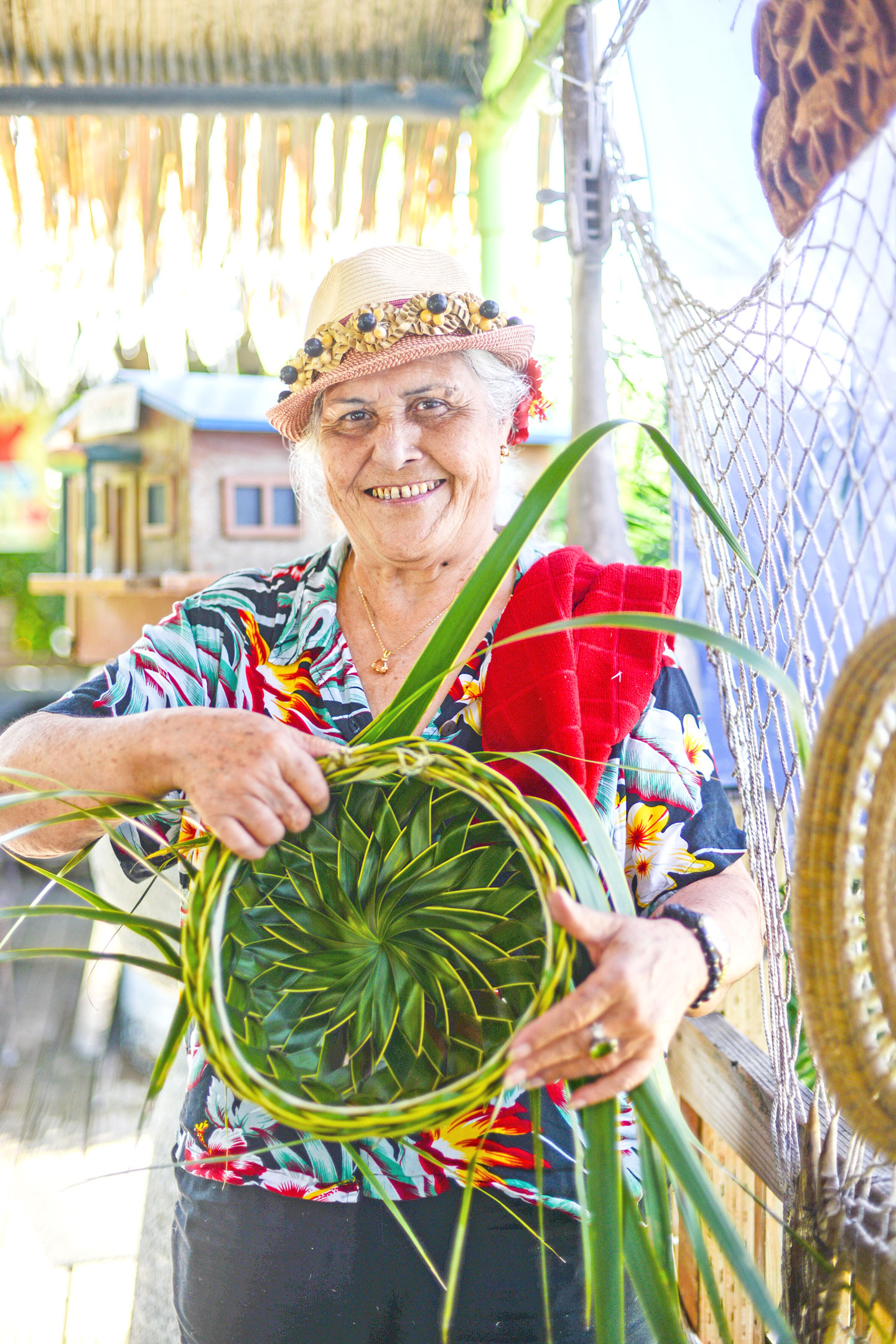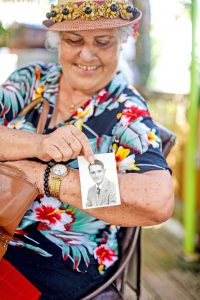YEH-YEH
Gloria Hunter: Mom, auntie, matriarch of Micronesia
‘Yes, I was an outsider. But that’s what I’d like to see—more acceptance and more camaraderie with people who choose to live here and be part of this place.’

“I wanted to get out and see something different,” Gloria Hunter said of when she originally left her native Palau for Saipan in high school. (Lindsay Nash)
The Yeh-Yeh series shares rich stories and oral traditions of Saipan. The name is inspired by Refaluwasch elder Lino Olapai’s childhood memory of being told to say “yehyeh” as the elders told stories. Once it was quiet, the elders knew the children were asleep.
To many here on Saipan, Gloria Hunter is “Mom.”
Sit with her for a moment at The Shack and you’ll see. Everyone knows “Mom.” Or “Auntie.”
Yes, she is the mother of Glen Hunter, the owner of this beloved beachside cafe, and three other children who all have made their own way in the world. But she’s also the warm, friendly woman who spent decades serving the CNMI government—for both parties.
“Why would anyone want to hear my stories?” she says.
Hunter, now 73, laughs easily at herself, her infectious free spirit on full display as she weaves vibrant green palm fronds into a basket on the front porch of The Shack.
She wears a floral-print blouse, and a splash of her curly gray hair flows out beneath a straw hat dotted with fake flowers, a tag hanging from the back in the style of Grand Ole Opry country star Minnie Pearl.
“I’m an outsider,” she says, explaining her circuitous path to where she sits today, just next to the Saipan lagoon. “I am a mixture of everything.”
Born on the island of Angaur in Palau to a part-Palauan, part-Yapese mother and an American father, she spent her childhood swimming in the ocean and running free through the jungle catching wild chickens.
“We didn’t have a TV. We didn’t have a radio,” she said. “We spent most of our time outside on the beach and in the ocean. I don’t remember learning how to swim. I just always knew.”
But it was the confines of her culture that drove her outward into the world.
Facing an arranged marriage to a boy she didn’t love and demanding matriarchal obligations, she applied for and received a scholarship at the age of 16 to attend Mt. Carmel School on Saipan through the Mercedarian Missionaries of Berriz.

Gloria Hunter shows a photo of her husband, who she met while working for the Yap legislature. (Lindsay Nash)
There were no high schools in Palau at the time and the opportunity was a perfect way to preserve her freedom and get an education, all at once. But she readily admits—she never wanted to be a nun.
“I wanted to get out and see something different,” Hunter said.
Back then, in the early ’60s, Saipan was still mostly jungle. The only transport on the island were bull carts and leftover war trucks. Even to get to Saipan, she had to fly on an Albatross seaplane from Koror to Guam, where she often got bumped for VIPs and had to wait for days—sometimes months—for the next plane.
In school at Mt. Carmel, Hunter often found herself on the receiving end of harsh punishments for her free-spirited ways. Like when she removed the screens to roam free or snuck snacks during Lent.
The only way she could communicate with her family was through a radio at the convent.
“Hi Dad…over,” she would say with the priest standing next to her, chiding her if she spoke negatively about her schooling or Saipan experience.
Once, when an opportunity arose to fly to Koror to surprise her parents, she showed up only to find out that her parents had moved. The letter they had sent informing her had been held by the nuns as punishment.
“They had moved to Yap!” she laughs.
Hunter has as many stories as the palm fronds she’s woven into baskets, a hobby she says she picked up to prove to her parents she wasn’t useless.
She can tell you how she met her husband at a government dinner for “old fuddy duddies” in Guam, when a handsome Coast Guard officer walked in who happened to be moving to Yap, where she lived.
Or how she and her handsome officer, now husband, moved from Yap to New York for his next station of duty. She arrived pregnant in the big city– but hadn’t yet realized it. “Now that was culture shock,” she says.
Or how she saw snow for the first time outside the hospital window when she was in labor with her first son. She thought the white flakes were ticker tape falling from the sky like she had seen after a recent baseball game, perhaps ordered up by her excited husband.
And the story of how she often swam in the Saipan lagoon at night when they moved back. Her husband and his other officers would line their trucks down the shoreline, facing the water, blinking their headlights into the dark lagoon until she swam ashore—usually around midnight.
As her husband hopped from post to post, Hunter eventually decided to return to Saipan for good. At that time, she had four young children. She knew Saipan would be a good home.
She has been here ever since. Now retired, she is one of the longest running Cabinet members in Micronesia, having served three governors of the CNMI as the special assistant for Programs and Legislative Affairs.
She is quick to credit former governor Pedro Tenorio for first hiring her.
“I’m an outsider,” she said. “A female. A nobody.”
But, over the years, Hunter proved herself and was hired time and again for the job for both political parties—an unusual feat for such a position.
“When I got in, I said, ‘I’m going to work my tail off. I’m going to prove to them I can do this job better than the others. And I did. I worked hard.”
Hunter has now finished weaving the basket. She ties one last frond along the bottom and nods at her handiwork.
“Yes, I was an outsider,” she says. “But that’s what I’d like to see—more acceptance and more camaraderie with people who choose to live here and be part of this place.”
Hunter smiles at a teenager who walks past. “How’s your grandmother?” she asks.
“Bye, Mom,” another woman says, leaving the cafe.
Hunter waves back, smiling. She, a matriarch of Micronesia—a mother to so many who call this island home.
Lindsay Nash (Special to the Saipan Tribune)
Lindsay Nash is a writer and photographer who lives on Saipan. She is a member of the Marianas Writers’ Movement and is currently writing a novel about 20th century Saipan. Email her at lindsayinsaipan@gmail.com.























